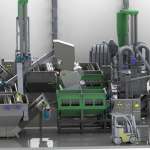Applications:
Conveyor belts are used for transporting a whole host of materials that an auger cannot: dry, granular, semi-dry materials, even boxed and bagged products, moving them horizontally, inclined or declined, to or from machinery, from storage vessels or as an integral part of a machine.
Conveyors can cope with such a huge range of materials due to the simple principle, where the material is dropped, placed, or laid onto the surface of the conveyor’s belt and is taken along with the belt, without any friction that enables abrasive, difficult, and large particle sized materials to be transported without any wear issues to the conveyor.
Limitations:
The only limitation is materials that can lay onto the belt without falling/running off or adhering to it, mainly pastes and semi-dry products that are too wet that would simply run off. To help retain materials can be addressed by having the belt-shaped to raise the outer edges into a shallow U shape formed by the belt’s bed rollers.
How they work:
Simple construction of three main elements, the support frame that incorporates the bed, return & tension rollers, the conveyor belt (continuous loop), and the two end pulleys (one being driven). The belt is routed over the bed rollers, around the end pulleys, over the underside return rollers (to stop the belt from sagging) and through the spring-loaded tension rollers (to keep the belt taught).
The drive, generally a geared electric motor, rotates one end pulley causing the belt to move. The material load gets taken along on the belt’s working top surface that is moving over the bed rollers.
Construction:
As the transported material is only in contact with the Belt, the frame construction doesn’t need to combat its abrasive nature, but any corrosiveness may need addressing as the return belt on the underside will drop material onto the frame, unless built-in channelling/ducting and/or belt cleaning (generally water jets) are fitted.
Canopies or fully enclosed covers can be fitted to stop the material from escaping or outside element contamination, or for safety reasons in certain situations.
The belts are mostly constructed from a rubber type of polymer that have many options of formed ridges on the working surface to cater for different material types to aid traction for mainly inclined and declined applications.
Related Videos:
Playlist

0.03

0.25









